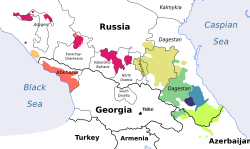Hinuq language
| Hinukh | |
|---|---|
| гьинузас мец / hinuzas mec | |
| Pronunciation | [hiˈnuzas mɛt͡s] |
| Native to | Russia |
| Region | Southern Dagestan |
| Ethnicity | Hinukh people |
Native speakers | 5 (2010 census)[1] |
Northeast Caucasian
| |
| Language codes | |
| ISO 639-3 | gin |
| Glottolog | hinu1240 |
| ELP | Hinukh |
The Hinuq language (autonym: гьинузас мец hinuzas mec, also known as Hinukh, Hinux, Ginukh, or Ginux) is a Northeast Caucasian language of the Tsezic subgroup. It is spoken by about 200 to 500 people, the Hinukhs, in the Tsuntinsky District of southwestern Dagestan, mainly in the village of Genukh (Hinukh: Hino). Hinukh is very closely related to Tsez, but they are not entirely mutually intelligible.
Only half of the children of the village speak the Hinukh language. As Hinukh is unwritten, like the other members of the Tsezic family, Avar and Russian are used as literary language. Hinukh is not considered to have dialects, but due to its linguistic proximity to Tsez it was once considered a Tsez dialect.
The Hinukh people were already mentioned in the Georgian chronicles of the Early Middle Ages. The language itself was first described in 1916 by Russian ethnographer A. Serzhputovsky.
Phonology
Vowels
Hinukh distinguishes 6 vowel qualities /a, e, i, o, u, y/, all of which can be either long or short. Two vowels can occur pharyngealized: /aˤ/ and /eˤ/. However, these are only used by the older generation. Today they are usually replaced by /i/.[citation needed]
Consonants
Morphology
It is an agglutinative language which makes mainly use of suffixes.
Nouns
Hinukh is an ergative-absolutive language and, like most Northeast Caucasian languages, shows a rich case system. The plural suffix is almost unvariably -be.
Verbs
Tenses are marked synthetically on the verbs by means of affixes. As its sister languages Bezhta and Tsez, Hinukh differentiates between "witnessed past" (ending in -s or -š) and "unwitnessed past" (in -no); the present tense is marked with the suffix -ho. In the future tense, Hinukh distinguishes a "direct future" (-n), which is used only in the first person, and an "indirect future" (-s) used for all other persons.
Numerals
The numeral system is vigesimal, which means that it is a base-20 system, a feature commonly found among the languages of the Caucasus.
References
- ^ Hinukh at Ethnologue (18th ed., 2015) (subscription required)
- Forker, Diana. A Grammar of Hinuq. Mouton Grammar Library [MGL] 63. DE GRUYTER Mouton, 2013. - 827 pages. ISBN 978-3-11-030397-1
External links
- The Peoples of the Red Book: THE HINUKHS
- Hinuq basic lexicon at the Global Lexicostatistical Database


